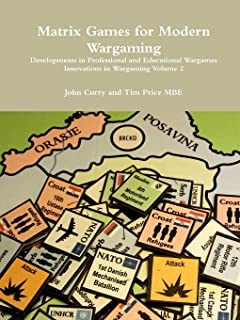The topic of matrix games has been popping up on my radar a lot lately.
 For those of you who are uncertain about the term, allow me a brief introduction. A matrix game is a talky talky exercise adjudicated by a referee and structured in such a way as to comprise a situational LARP. Players are assigned roles, given goals, and presented with a list of potential allies and enemies. In each turn of the exercise, each player is allowed to make a statement about what will happen, along with reasons why their desired outcome will result. Other players have an opportunity to support or hinder that outcome. Based on the arguments presented, the referee will make a ruling about what happens, or perhaps will determine the likelihood, or odds of, that result. Then the referee will use a randomizer such as dice or playing cards to determine the result. This is a very political exercise that is typically used to help analyze complex political situations and provide some limited predictive ability for a real-world situation.
For those of you who are uncertain about the term, allow me a brief introduction. A matrix game is a talky talky exercise adjudicated by a referee and structured in such a way as to comprise a situational LARP. Players are assigned roles, given goals, and presented with a list of potential allies and enemies. In each turn of the exercise, each player is allowed to make a statement about what will happen, along with reasons why their desired outcome will result. Other players have an opportunity to support or hinder that outcome. Based on the arguments presented, the referee will make a ruling about what happens, or perhaps will determine the likelihood, or odds of, that result. Then the referee will use a randomizer such as dice or playing cards to determine the result. This is a very political exercise that is typically used to help analyze complex political situations and provide some limited predictive ability for a real-world situation.
To take just one example, consider the collapse of the American experiment in Afghanistan. Do you want to know what will happen over the next 5 years? Grab 10 friends, stick them in a room, and assign two of them to play the Americans, two of them to play the Russians, two of them to play the Chinese, two of them to play the Indians, and two of them to play the Iranians. You might assign somebody to play the role of the Taliban, however as an organization with a limited amount of influence in the region, their task will primarily be to play each of those sides off the other. They are a secondary actor, not a primary actor, within the scope of this exercise.
At this point I have to admit that I have only just begun my journey into this world. From what I have seen so far, I am not impressed.
 Matrix games are a tool. When used properly, they can be of great assistance in understanding complex situations. However, the phrase “when used properly” is carrying a lot of weight. These are simply tools. They are models that use flesh and blood computers in place of silicon microchips. That is an improvement, and one that allows for a much more subjective level of analysis, like all models, these games are limited by the principle of garbage in garbage out. They are also highly susceptible to the biases of the individuals who are constructing the initial state and the outside influences of the model.
Matrix games are a tool. When used properly, they can be of great assistance in understanding complex situations. However, the phrase “when used properly” is carrying a lot of weight. These are simply tools. They are models that use flesh and blood computers in place of silicon microchips. That is an improvement, and one that allows for a much more subjective level of analysis, like all models, these games are limited by the principle of garbage in garbage out. They are also highly susceptible to the biases of the individuals who are constructing the initial state and the outside influences of the model.
Matrix games bear the weight of all of the weaknesses of the climate models that have failed so spectacularly over the last 30 years. Like climate models, they are a very valuable tool for the propaganda set. They allow an organization to set up a system that will produce their desired result, and they do it in such a way as to allow for the presentation of those results with the patina of independent and objective procedural analysis. These are camouflage.
Even worse, the sorts of big-brained fellas who put these models together are the types of individuals most likely to suffer from a severe case of Dunning-Kruger syndrome. They are smart enough to analyze the actors, and smart enough to see the list of potential outcomes, and to build their models accordingly. Which means these games are while we vulnerable to wild card actors whom the modelers cannot take seriously until it is too late.
Imagine conducting a matrix game in 2015, with a desire to understand how the 2016 United States presidential election will run. How could you predict the rise of Donald Trump? Or a 2019 matrix game designed to understand the 2020 election that ruled out the potential for widespread election fraud.
And that letter example brings us neatly to one of the key weaknesses of using matrix games to understand the processes by which international politics operates today. Here is a video by a gentleman named Tom Mouat. Aside from the visceral distaste he has for white males – he never misses an opportunity in this lecture to badmouth them – All of times international games operate at a secondary actor level. He wants to know how Russia, or China, or the EU, or the United States government – not to be confused with the American people, mind you – will behave, without ever once asking a far more fundamental question.
What do the primary actors want? Who are the primary actors? What resources will they dedicate to steering the secondary actors listed above in the direction of their desires?
You cannot understand the international order of the world today if you cannot even speak the name of the primary motivators.
And those primary motivators, the ones who are most likely to use taxpayer funds to pay for these sorts of exercises, are smart enough and wealthy enough to ensure that the people they hire, people like Tom Mouat will not speak their name. They lurk in the background, and a great many politicians – both those in office and those legions of mandarins in the diplomatic and military corps – are eager to use these tools to provide the covering fire of a seemingly independent process to lend credibility to their busted out of the gate plans for increasing their own power and influence over the rubes out in flyover country.
Tom is a good boy. Tom knows who butters his bread. Tom won’t set up a game that threatens his livelihood, his prestige, or his reputation. And so every matrix game he runs, begins its life with a crippling genetic defect. They might arrive at reasonable answers to the questions he poses, but they are hamstrung by his need to ask all the wrong questions.
And so, as a neophyte to this style of gaming, I am unimpressed.
Stay tuned for further analysis.


